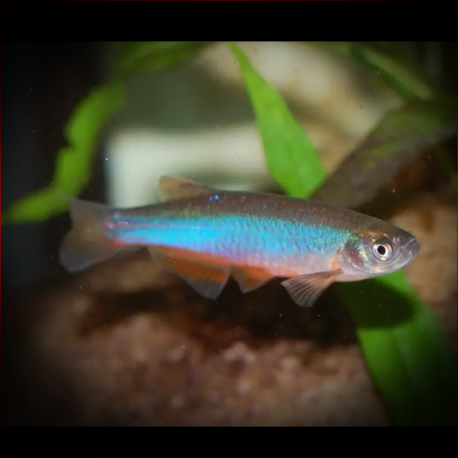More info
Datasheet
| Minimum Tank Size | 80 litres / 21.13 US gallons |
| Maximum Size | 5.5cm / 2.17inches |
| Temperature | 18°C / 64.40°F - 25°C / 77.00°F |
| Hardness | 2.02dgH / 36ppm - 15.02dgH / 268ppm |
| pH | 6.0-7.5 |
General Description
Brachydanio Rosea, commonly known as Rosy 'Danio', is a peaceful and colorful species that has become popular in the aquarium trade due to its hardiness and affordability. It closely resembles B. albolineata but can be distinguished by its slimmer body, shorter rostral barbels, and lack of dark stripes on the posterior half. Breeding practices have led to potential hybrids in the trade. The species belongs to the Cyprinidae family and belongs to the Cypriniformes order.
Aquarium Setup
For optimal care, it is recommended to keep Brachydanio Rosea in a well-furnished community tank with a group of 8-10 specimens to encourage schooling behavior. The aquarium should be heavily planted with a dark substrate to enhance the fish's coloration. Maintaining a flowing river-like setup with rocks, gravel, boulders, and driftwood mimics its natural habitat. A tightly-fitting cover is essential as these fish are known jumpers. Water conditions should be maintained at a temperature of 18-25°C, pH of 6.0-7.5, and hardness of 36-268ppm.
Behaviour
Being a schooling species, Brachydanio Rosea thrives when kept in groups. It competes for female attention, displaying its best colors when in decent numbers. Its peaceful nature allows it to coexist with a variety of fish species in a community tank without special water chemistry requirements.
Feeding and Diet
In its natural habitat, Brachydanio Rosea preys mainly on insects and their larvae. In the aquarium, it is an unfussy eater and readily accepts most foods, including dried products as a staple diet. Feeding should be supplemented with live and frozen fare such as bloodworms, Daphnia, and Artemia to enhance coloration and overall conditioning.
Reproduction & Dimorphism
This species is an egg-scattering spawner, displaying no parental care. Controlled breeding can be achieved by providing separate breeding containers with low light and suitable substrate for egg scattering. Females tend to be larger and deeper-bodied, especially when gravid. Incubation usually takes 24-36 hours, with the young becoming free-swimming a few days later.
Habitat and Distribution
Brachydanio Rosea is commonly found in well-oxygenated streams under forest cover, but it has also been recorded in backwaters and larger rivers. Its distribution includes the Mekong River basin in parts of Thailand, Laos, and Myanmar. Sympatric species include Brachydanio albolineata and unidentified members of Barilius and Opsarius in similar habitats.

